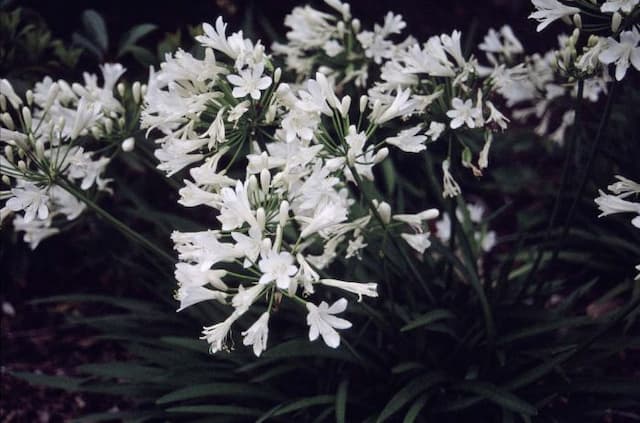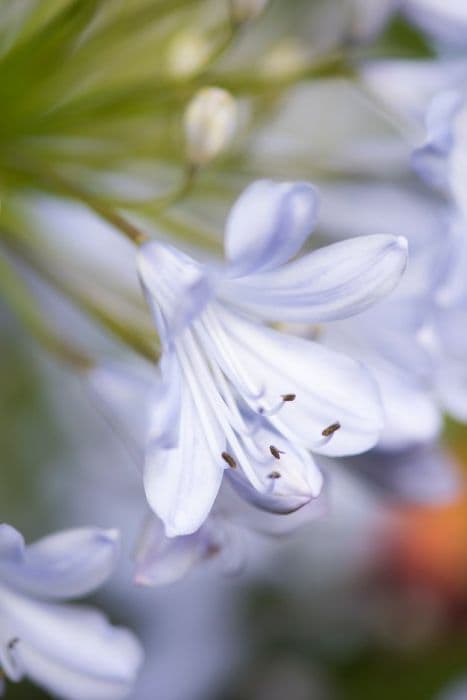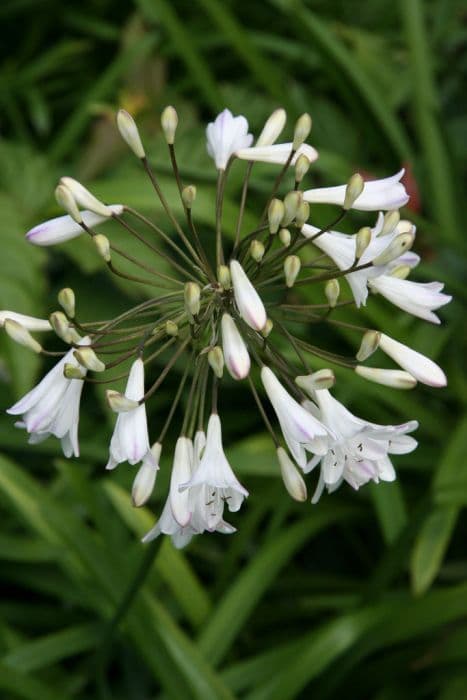African Lily Agapanthus 'Full Moon'

ABOUT
Agapanthus 'Full Moon' is a striking plant, popularly known as the African Lily, characterized by its bold and showy flowers. The blooms of the African Lily 'Full Moon' are a notable feature, appearing in large, rounded clusters of trumpet-shaped flowers at the end of tall, upright stems. The flowers are typically a soft, pale blue color, giving a serene and calming appearance. The lush, strap-like leaves are a deep green color and form a dense clump, which provides a lush backdrop for the light-colored blooms. The leaves have a glossy texture and arch gracefully, adding to the overall elegance of the plant. With its distinctive flower heads that resemble orbs of moonlight, the African Lily 'Full Moon' is a beautiful and eye-catching addition to any garden space.
About this plant
 Names
NamesFamily
Amaryllidaceae.
Synonyms
African Lily, Lily of the Nile, Love Flower.
Common names
Agapanthus 'Full Moon'
 Toxicity
ToxicityTo humans
African Lily, commonly known as Agapanthus 'Full Moon', is known to be mildly toxic if ingested. The whole plant contains compounds that may cause symptoms such as nausea, vomiting, and diarrhea. In some cases, skin contact with the sap can result in irritation or dermatitis. It is advisable to handle the plant with care and to ensure that it is not consumed.
To pets
African Lily, commonly known as Agapanthus 'Full Moon', is considered to be toxic to pets, including cats and dogs. If ingested, pets may experience symptoms such as nausea, vomiting, and diarrhea. The severity of the symptoms can vary depending on the amount consumed. It is important to keep this plant out of reach of pets and to contact a veterinarian if you suspect your pet has ingested any part of it.
 Characteristics
CharacteristicsLife cycle
Perennials
Foliage type
Evergreen
Color of leaves
Green
Flower color
White
Height
2 feet [60 cm]
Spread
2 feet [60 cm]
Plant type
Herb
Hardiness zones
8
Native area
South Africa
Benefits
 General Benefits
General Benefits- Attractive Blooms: The Agapanthus 'Full Moon', commonly known as Lily of the Nile, features beautiful globular clusters of flowers that add aesthetic appeal to gardens and landscapes.
- Drought Tolerance: Once established, Lily of the Nile is quite drought-tolerant, making it suitable for regions with low rainfall or for gardeners aiming to reduce water use.
- Low Maintenance: This plant requires minimal care beyond the initial planting and establishment phase, making it a convenient choice for busy or novice gardeners.
- Pest Resistance: Lily of the Nile is resistant to most pests, ensuring fewer pest-related problems and potentially reducing the need for chemical treatments.
- Attracts Pollinators: The vibrant blooms attract bees, butterflies, and other beneficial pollinators, supporting biodiversity in the garden environment.
- Versatile Landscaping: Agapanthus 'Full Moon' can be used in a variety of landscaping scenarios, from border plantings to container gardening.
- Long Blooming Season: It typically has a long flowering period throughout the summer, providing a lengthy display of visual interest.
- Deer Resistance: The plant is known to have a degree of deer resistance, which is beneficial in areas where deer predation is a concern for gardeners.
 Medical Properties
Medical PropertiesThis plant is not used for medical purposes.
 Air-purifying Qualities
Air-purifying QualitiesThis plant is not specifically known for air purifying qualities.
 Other Uses
Other Uses- As a Natural Dye: The blue or purple shades of the Agapanthus flowers can be used to create natural dyes for fabrics or crafts.
- Photography Subject: With their eye-catching blooms, Agapanthus 'Full Moon' serves as a popular subject for garden and macro photography.
- Educational Tool: Agapanthus can be used in botanical studies or as an educational tool to discuss pollination and plant biology due to their unique flower structure.
- Pond Borders: Because of their clumping nature, they can be planted around ponds as a decorative border that provides a natural look.
- Insect Habitat: Agapanthus can provide a habitat for beneficial insects, including bees and butterflies, which are attracted to the flowers’ nectar and pollen.
- Floral Arrangements: The long stems and striking blooms of Agapanthus make them ideal for inclusion in fresh or dried floral arrangements.
- Garden Sculpture Compliment: Their vertical growth form and architectural flowers can complement garden sculptures by adding a soft, natural contrast.
- Garden Themed Art: Artists can use the form and color of Agapanthus as inspiration in creating garden-themed artwork, such as paintings or textile designs.
- Culinary Garnish: While not a common practice, the flowers can be used as a garnish for food presentation, assuming no pesticide has been used.
- Creative Crafts: Dried seed heads can be incorporated into crafts, such as wreaths or dried flower arrangements, adding texture and interest.
Interesting Facts
 Feng Shui
Feng ShuiThe Agapanthus, commonly known as Lily of the Nile, is not used in Feng Shui practice.
 Zodiac Sign Compitability
Zodiac Sign CompitabilityThe Lily of the Nile is not used in astrology practice.
 Plant Symbolism
Plant Symbolism- Love Letters: The name "Agapanthus" is derived from the Greek words "agape" (love) and "anthos" (flower). This plant is often considered to symbolize love messages or letters.
- Beauty: Agapanthus, commonly known as African Lily, has striking blue or purple flowers, which are seen as a symbol of beauty and elegance.
- Endurance: African Lilies are hardy plants that can withstand a range of conditions. They represent endurance and survival.
- Friendship: Given as a gift, it can express the sentiment of deep, platonic affection, standing for lasting friendship.
- Fertility: Because of their lush growth and round umbel flower heads, they can be associated with fertility and abundance.
 Water
WaterLily of the Nile requires regular watering, especially during its active growing season in the spring and summer. It should be watered deeply about once a week, allowing the water to reach the roots without leaving the soil waterlogged. Typically, a gallon for outdoor plants or few ounces for potted specimens is a good measure to start with; adjust depending on the size of your plant and the weather conditions. During the winter, when the plant is dormant, reduce the frequency of watering, allowing the soil to dry out partially between waterings.
 Light
LightLily of the Nile thrives in full sun to partial shade conditions. The best spot for this plant would be where it receives at least 6 hours of direct sunlight per day. If grown indoors, place near a bright window to ensure it gets ample light, but avoid intense afternoon sun if possible to prevent scorching the foliage.
 Temperature
TemperatureLily of the Nile prefers moderate to warm temperatures and should be protected from extreme cold. The ideal temperature range for this plant is between 50°F and 80°F. It can tolerate temperatures down to about 30°F, but anything lower can cause damage or kill the plant. If frost is expected in your area, provide protection or move potted plants indoors.
 Pruning
PruningPruning Lily of the Nile is important for encouraging a more vigorous bloom and maintaining a tidy appearance. The best time for pruning is in the late winter or early spring, before new growth begins. Remove spent flower stalks and any dead or damaged foliage. Pruning can be done annually, as it helps to rejuvenate the plant and prompt a better display of flowers.
 Cleaning
CleaningAs needed
 Soil
SoilThe best soil mix for the Lily of the Nile is well-draining soil enriched with organic matter. It should have a slightly acidic to neutral pH ranging from 6.0 to 7.5. A blend containing loam, compost, and sand or perlite is ideal to ensure adequate drainage and fertility.
 Repotting
RepottingLily of the Nile should generally be repotted every 2 to 3 years, or when it becomes root-bound. Early spring, just before the new growth starts, is the best time to repot this plant.
 Humidity & Misting
Humidity & MistingLily of the Nile prefers moderate humidity levels but is quite adaptable and doesn’t require any special humidity requirements. It can thrive in the typical humidity levels found in most outdoor garden settings.
 Suitable locations
Suitable locationsIndoor
Ensure bright light, well-draining soil, and pot with drainage holes.
Outdoor
Plant in full sun to partial shade, well-draining soil, and mulch.
Hardiness zone
8-11 USDA
 Life cycle
Life cycleAgapanthus 'Full Moon', commonly known as Lily of the Nile, begins its life cycle as a seed which germinates in soil with adequate moisture, warmth, and light conditions. Once germinated, the seedling emerges and develops into a young plant with strap-like leaves, establishing roots and foliage during the growth stage. As the plant matures, it develops a strong root system and enters the vegetative stage, during which it continues to produce more leaves and increases in size. The plant then enters the flowering stage, typically during the summer months, producing tall stems topped with globular clusters of blue or white flowers. After pollination, if it occurs, the flowers produce seed pods that mature and eventually release seeds, completing the reproductive cycle. Throughout its life, Agapanthus 'Full Moon' will undergo periods of active growth and dormancy, typically experiencing a rest period during the cooler winter months before resuming growth in the spring.
 Propogation
PropogationPropogation time
Spring-Early Summer
The most popular method of propagating the Agapanthus 'Full Moon', commonly known as Lily of the Nile, is through division. This is ideally done in the spring or early fall. To propagate by division, first carefully lift the clump of Agapanthus from the ground with a garden fork or spade, taking care not to damage the roots. Once the clump is out of the ground, use your hands or a knife to gently separate the clump into smaller sections, each with at least one or two growing points. Replant these divisions immediately at the same soil depth they were previously growing, ensuring they have enough space for root development. Water the newly planted divisions thoroughly to help establish them. This method promotes quicker flowering compared to seed propagation and maintains the characteristics of the parent plant.



![African lily [Blue Storm]](/_next/image?url=https%3A%2F%2Fplants-admin.emdemapps.com%2Fimages%2Fplants%2F%2Fimages%2F604b63200a08b.png&w=640&q=75)





